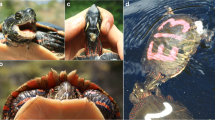Abstract
Elasmobranch fishes exhibit a series of complex courtship and mating behaviours in which males inflict significant bite wounds to the body of female mates. However, the variety and frequency of mating wounds are not known across a full reproductive season for any species. We examined the distribution and abundance of dermal wounds in adult Atlantic stingrays, Dasyatis sabina, which have a protracted and defined mating season to determine (1) if dermal wounds can be used as indicators of mating activity, (2) whether different categories of bite wounds can be associated with specific mating behaviours, and (3) whether the skin thickness in females is sexually dimorphic. Adults of both sexes showed fresh wounds during the full duration of the mating season (October–June) and there was no relationship between ray size and wound density. Females had more total wounds than males in every month with a maximum average of 20.2 wounds per female in April. Mating wounds were categorized into five distinct forms: single track, double track, bite, margin abrasion and excision. Wounds were randomly distributed over the body of males but concentrated on the posterior half of the disc in females. Each wound type occurred in approximately equal proportions among sexes with the exception of the precopulatory and copulatory-induced margin abrasions which accounted for 13.7% of the total wounds in females but only 3.1% in males. We suggest that the pronounced and concurrent appearance of single track, double track and bite wounds among males results from random premating courtship attacks by males because females cannot be visually discriminated. However, the concentration of wounds on the posterior disc of females is consistent with the possible presence of olfactory cues (e.g. pheromones) that are released at the cloaca. The pectoral fin dermis of females was 50% thicker than that of males, which eliminated the excision of margins during male grasping and functions to reduce female injury. The temporal occurrence of wounds from October through June and peak in April is consistent with previous reproductive studies that show fresh sperm in the reproductive tract of females over the protracted mating period and also ovulation in late March or early April. The importance of social reproductive biting is discussed in relation to the reproductive induction hypothesis proposed to possibly explain the protracted mating of this species. Monitoring of dermal wounds provides a useful non-invasive technique to determine reproductive activity and a means for inference of social relationships in elasmobranch populations.
Similar content being viewed by others
References cited
Bigelow, H.B. & W.C. Schroeder. 1953. Fishes of the Western North Atlantic. Sawfishes, guitarfishes, skates and rays. Memoires of the Sears Foundation for Marine Research 1, part 2. 588 pp.
Carrier, J.C., H.L. Pratt, Jr. & L.K. Martin. 1994. Group reproductive behaviors in free-living nurse sharks, Ginglymostoma cirratum. Copeia 1994: 646–656.
Enders, R.K. 1952. Reproduction in the mink (Mustela vison). Proc. Amer. Philos. Soc. 96: 691–755.
Feduccia, A. & B.H. Slaughter. 1974. Sexual dimorphism in skates (Rajidae) and its possible role in differential niche utilization. Evolution 28: 164–168.
Johnson, R.H. & D.R. Nelson. 1978. Copulation and possible olfaction-mediated pair formation in two species of carcharhinid sharks. Copeia 1978: 539–542.
Kajiura, S.M. & T.C. Tricas. 1996. Seasonal dynamics of dental sexual dimorphism in the Atlantic stingray, Dasyatis sabina. J. Exp. Biol. 199: 2297–2306.
Klimley, A.P. 1980. Observations of courtship and copulation in the nurse shark, Ginqlymostoma cirratum. Copeia 1980: 878–882.
Klimley, A.P. & D.R. Nelson. 1981. Schooling of the scalloped hammerhead shark, Sphyrna lewini, in the Gulf of California. U.S. Fish. Bull. 79: 356–360.
Lewis, T.C. 1982. The reproductive anatomy, seasonal cycles, and development of the Atlantic stingray, Dasyatis sabina (LeSueur) (Pisces, Dasyatidae). Ph.D. Dissertation, Florida State University, Gainesville. 206 pp.
Luer, C.A. & P.W. Gilbert. 1985. Mating behavior, egg deposition, incubation period, and hatching in the clearnose skate, Raja eglanteria. Env. Biol. Fish. 13: 161–171.
Maruska, K.M., E.G. Cowie & T.C. Tricas. 1996. Periodic gonadal activity and protracted mating in elasmobranch fishes. J. Exp. Zool. 276: 219–232.
McCourt, R.M. & A.N. Kerstitch. 1980. Mating behavior and sexual dimorphism in dentition in the stingray Urolophus concentricus from the Gulf of California. Copeia 1980: 900–901.
McEachran, J.D. 1975. Reply to 'Sexual dimorphism in skates (Rajidae)'. Evolution 31: 218–220.
Nordell, S.E. 1994. Observations of the mating behavior and dentition of the round stingray, Urolophus halleri. Env. Biol. Fish. 39: 219–229.
Pearson, O.P. 1944. Reproduction in the shrew (Blarina brevicauda Say). Amer. J. Anat. 75: 39–93.
Pratt, H.L., Jr. 1979. Reproduction in the blue shark, Prionace glauca. U.S. Fish. Bull. 77: 445–470.
Reed, J.K. & R.G. Gilmore. 1981. Inshore occurrence and nuptial behavior of the roughtail stingray, Dasyatis centroura (Dasyatidae), on the continental shelf, east central Florida. Northeast Gulf Sci. 5: 59–62.
Snelson, F.F., S.E. Williams-Hooper & T.H. Schmid. 1988. Reproduction and ecology of the Atlantic stingray, Dasyatis sabina, in Florida coastal lagoons. Copeia 1988: 729–739.
Springer, S. 1960. Natural history of the sandbar shark, Eulamia milberti. Fishery Bull. Fish Wildl. Serv. U.S. 61: 1–38.
Stevens, J.D. 1974. The occurrence and significance of tooth cuts on the blue shark (Prionace glauca L.) from British waters. J. Mar. Biol. Ass. U.K. 54: 373–378.
Tricas, T.C. 1980. Courtship and mating-related behaviors in myliobatid rays. Copeia 1980: 553–556.
Tricas, T.C. & E.M. LeFeuvre. 1985. Mating in the reef white-tip shark Triaenodon obesus. Mar. Biol. 84: 233–237.
Author information
Authors and Affiliations
Rights and permissions
About this article
Cite this article
Kajiura, S.M., Sebastian, A.P. & Tricas, T.C. Dermal Bite Wounds as Indicators of Reproductive Seasonality and Behaviour in the Atlantic Stingray, Dasyatis sabina. Environmental Biology of Fishes 58, 23–31 (2000). https://doi.org/10.1023/A:1007667108362
Issue Date:
DOI: https://doi.org/10.1023/A:1007667108362




